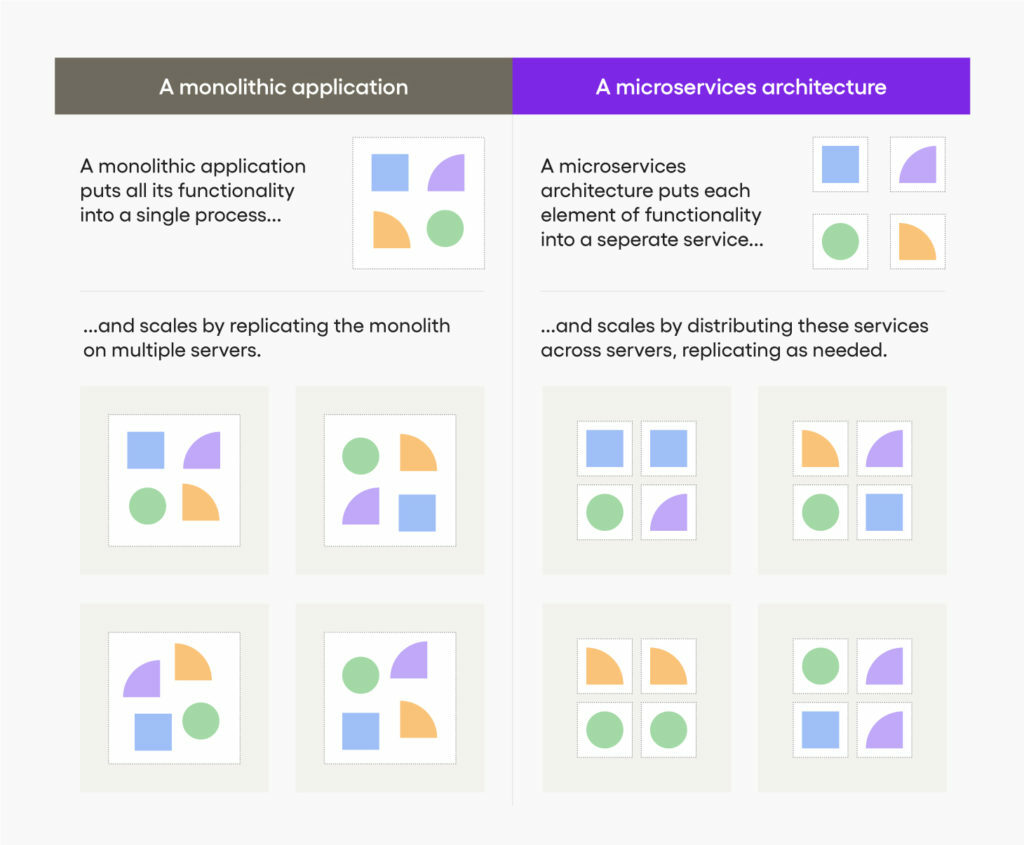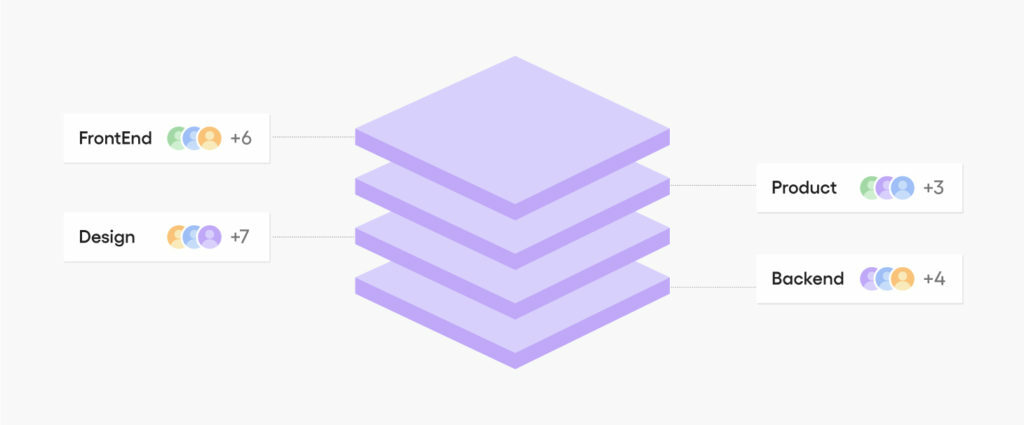The case for microservices is upon us

If you’re in the process of roadmapping your app or platform, it’s time to give your architecture some serious thought. One of the key considerations to take into account is whether you’ll adopt a microservices approach or take a more traditional monolithic route.
A microservices-based architecture offers many benefits, including improved scalability, better security and greater efficiency – not to mention the potential to significantly reduce time to market when adding new features.
Let’s take a closer look.
What are microservices?
Microservices – also sometimes known as microservices service-orientated architecture – is a way of structuring software development as a collection of smaller, modular applications that communicate via API, instead of a single monolithic program.
Monolithic architecture is still the predominant architectural style, but for reasons we’ll get into below, a growing number of companies like Groupon, Amazon, Netflix, Soundcloud, Uber, and many more are adopting a microservices architecture.
For example, an on-demand food delivery app might comprise the following modular services:
- User management
- Menu management
- Customer order management
- In-app messaging
- GPS route planning
- Delivery management
- Payment
- Rewards program management
- Customer review management
- Personalized product recommendations

Characteristics of a microservice architecture
An application created using a microservices architecture is essentially a suite of services that run independently and communicate via lightweight mechanisms such as RESTful APIs. Centralized management is at a minimum, allowing each team to use their own preferred methods and technologies.
Some of the characteristics of microservices include:
- Microservices are loosely coupled,
- Microservices can be deployed independently,
- Microservices tend to be based on business capabilities,
- It’s easy to integrate plug-and-play third-party APIs,
- Each microservice runs its own process, so they’re easy to test, maintain and update,
- Each microservice is typically owned by a small team.
Such a high level of independence can lead to organizational siloing and creates a need for rigorous quality standards and meticulous documentation and reporting. As such, it’s not advisable to adopt microservices without also implementing DevOps or managed cloud services.
Whereas a monolithic application is built as a single application, typically consisting of three parts – a front-end/client-side user interface, a database, and a back-end/server-side application – a microservices architecture will feature multiple smaller server-side applications and use a REST service to call on services individually as they’re needed.
Ready for the next level?
Use cases of microservices
The use cases for microservices are endless. To get an idea of the wide applications of this architecture, let’s take a look at how verticals that have been early microservices adopters have benefited from implementing microservices.
Retail
Ecommerce companies like Amazon and eBay have found value in the reliable availability and scalability of microservices, as well as the ease of resolving bugs.
Media and entertainment
Streaming and gaming companies like Netflix and Playstation have benefited from the ability to reduce latency when handling high volumes of requests.
Healthcare
As digital healthcare gains momentum, health apps are finding that microservices help to facilitate shorten development pipelines and allow for faster adoption – and deployment – of innovative technology. The healthcare microservices market is projected to grow from $130 million in 2018 to $519 million by 2025.
Finance, insurance, and banking
For the financial services industry, advantages of microservices include higher security standards thanks to the use of a separate service for user identity management and authentication, shorter time-to-market on new features, and the ease of managing API layers.
Are microservices the future?
For many businesses, monolithic architecture has been and will continue to be sufficient. However, with the rise of mobile browsing and the growing ubiquity of omnichannel service delivery, many businesses are finding their code libraries become more convoluted and difficult to maintain with each passing year.
As businesses scale and expand their business capabilities, they often run into the issue that the code behind their various components is too tightly bound in a monolithic structure. This makes it difficult to deploy updates and fixes because change cycles are tied together, which means they need to update the whole system at once instead of simply updating the single function that needs improvement.
Microservices architecture is one of the ways companies are overhauling their tech stacks to keep up with modern DevOps best practices and future proof their operations, making them more flexible and agile.
Given the rapid pace of change where technologies and consumer expectations are concerned, businesses that do not build capacity for agility and scalability into their business model are placing themselves at a disadvantage – particularly at a time when businesses are being forced to pivot frequently in response to widespread market instability.
An important consideration to note is that you don’t necessarily need to start from scratch when implementing microservices. You can start overhauling your legacy system by gradually peeling off individual services and turning them into microservices, or by integrating free-standing services into your existing monolith via API.
Benefits of microservices
While the key benefits of implementing microservices should already be clear, let’s look at some of the other benefits:
Greater efficiency – and accountability
With a microservices architecture, businesses can establish service boundaries and assign single-function services — such as “user authentication,” “in-app messaging” or “payments processing” — to individual teams, each with their own budget and roadmap. This allows for greater continuity and accountability by allowing businesses to give teams ownership of a product for the duration of its lifespan.

More scalable
With a loosely coupled architecture, it’s possible to scale individual services without necessarily needing to scale the entire app, saving resources such as server space. Independent teams can also scale at different rates as bottlenecks and collaboration issues virtually disappear.
More agile
Microservices allow you to rapidly deploy fixes to services without downtime for the rest of the application. Another bonus of microservices architecture is that you can reuse code snippets across services, which can significantly speed up development cycles.
More flexible
Developers can use whichever language, SDK, or stack is most suited to the individual service, rather than needing to code the entire application in the same language. This allows them to use the tools most suited for the job, which can result in better, faster functioning. However, this can lead to overly clunky code libraries and documentation and multiple database versions that need ongoing maintenance, which can become costly.
Reduced risk
Because each service is isolated and treated as a product in its own right, the risk to your app is reduced. If something goes wrong in one component, the potential extent of the damage is limited to a single product as opposed to affecting the entire application.
More shortcuts
One of the greatest advantages of a microservices architecture is the ease with which you can integrate existing services such as an inventory management module or an in-app chat function into your application using an API. You can also use SDKs like the ones Sendbird offers to fast-track your development pipeline and reduce your time to market.
Closing thoughts
In a time of uncertainty and rapidly changing circumstances, it’s even more of an advantage than usual to be able to pivot and adapt than usual. Microservices equips teams to build, integrate, and deploy new features and update existing services with far greater agility, flexibility, and ease than monolithic architecture.
For instance, if you’re currently trying to improve your communication and customer service to provide your customers with increased touchpoints and a more human experience of your brand, you can easily roll out robust in-app chat, voice calls and even video calling with Sendbird’s API – without needing to rebuild huge parts of your existing application to do so.










